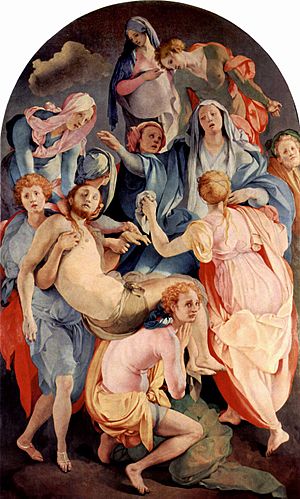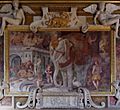Mannerism facts for kids
Mannerism was a special art style from the Late Renaissance period. It lasted from about 1520 to 1600. In Mannerist paintings and sculptures, people often look "elongated" (stretched out) or "distorted" (made into strange shapes). Artists usually wanted their art to look very "elegant."
How Mannerism Began
This art style started in Italy. Artists there were inspired by Michelangelo's famous paintings. He painted on the ceiling of the Sistine Chapel and created the "Last Judgement."
During the Renaissance, artists like Leonardo da Vinci and Raphael worked hard. They wanted to paint things in a very realistic way. They studied nature carefully. Both Leonardo and Raphael died around 1520.
After them, many artists decided to use painting to "express themselves." They did not always follow the strict rules of anatomy (how the body is built) or perspective (making things look far away or close). Mannerist paintings often show figures that seem to be twisting or fighting. The faces in these artworks often show strong feelings. These can include sadness, fear, or even anger.
Famous Mannerist Artists
Not all artists working during this time painted in the Mannerist style. Many continued to use the High Renaissance style.
Some important Mannerist painters were Tintoretto, Jacopo Pontormo, Agnolo Bronzino, Parmigianino, and Rosso Fiorentino. Giambologna and Benvenuto Cellini were famous Mannerist sculptors. Giulio Romano was a Mannerist architect.
Mannerism spread from Italy to other countries. It reached France, Germany, and Spain. One of the most famous Mannerist painters was El Greco, who worked in Spain.
Other artists who used this style include the French sculptor Jean Goujon. The Dutch painter Abraham Bloemaert and the German painter Bartolomeus Spranger also painted this way. Perhaps the most unusual paintings from this time were by Giuseppe Arcimboldo. He made pictures where people's faces looked like they were made from fruit, flowers, fire, or even fish!
Gallery
Images for kids
-
Jacopo Tintoretto, Last Supper, 1592–1594
-
The Vleeshal in Haarlem, Netherlands
-
The Town Hall in Zamość, Poland, designed by Bernardo Morando.
-
Apollo's sculpture, Palazzo Giusti Verona, Mannerism art with typical Contrapposto
-
Giambologna, Samson Slaying a Philistine, about 1562
-
Rosso Fiorentino, Francois I Gallery, Château de Fontainebleau, France
-
Giuseppe Arcimboldo, Autumn, 1573, oil on canvas, Louvre Museum, Paris
-
Bronzino, Portrait of Bia de' Medici, c. 1545
-
El Greco, Baptism, c. 1614
-
One of the best examples of Mannerist architecture: Palazzo Te in Mantova, designed by Giulio Romano
-
Baldassare Peruzzi, Palazzo Massimo alle Colonne in Rome
-
St. John's Co-Cathedral in Valletta, Malta
-
Cathedral Basilica of Salvador, Brazil, built between 1657 and 1746, a UNESCO World Heritage Site.
-
The large Basilica of San Francisco, in Quito, Ecuador, built between 1535-1650.
See also
 In Spanish: Manierismo para niños
In Spanish: Manierismo para niños
























